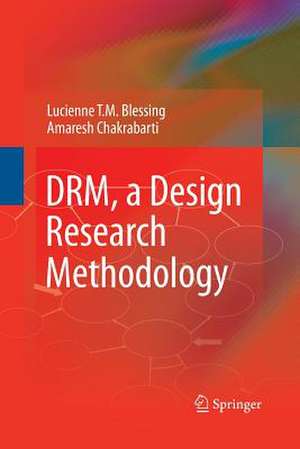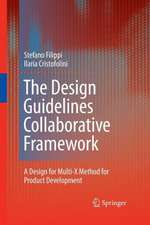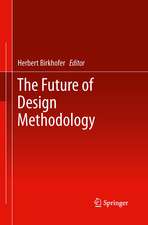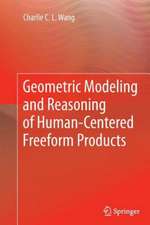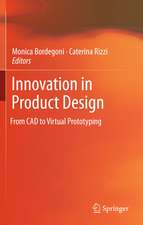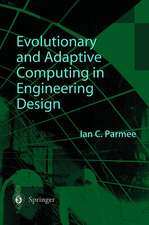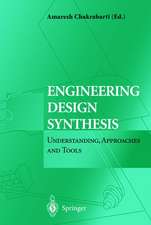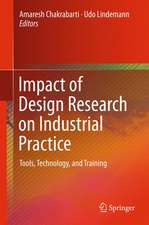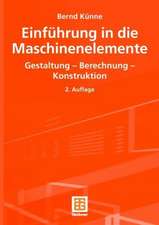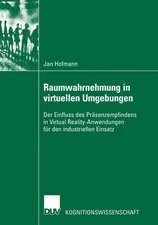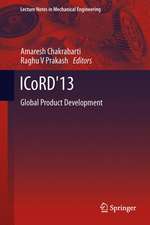DRM, a Design Research Methodology
Autor Lucienne T.M. Blessing, Amaresh Chakrabartien Limba Engleză Paperback – 26 noi 2014
| Toate formatele și edițiile | Preț | Express |
|---|---|---|
| Paperback (1) | 1217.10 lei 6-8 săpt. | |
| SPRINGER LONDON – 26 noi 2014 | 1217.10 lei 6-8 săpt. | |
| Hardback (1) | 1223.22 lei 6-8 săpt. | |
| SPRINGER LONDON – 30 iun 2009 | 1223.22 lei 6-8 săpt. |
Preț: 1217.10 lei
Preț vechi: 1484.26 lei
-18% Nou
Puncte Express: 1826
Preț estimativ în valută:
232.97€ • 253.14$ • 195.82£
232.97€ • 253.14$ • 195.82£
Carte tipărită la comandă
Livrare economică 21 aprilie-05 mai
Preluare comenzi: 021 569.72.76
Specificații
ISBN-13: 9781447157748
ISBN-10: 1447157745
Pagini: 416
Ilustrații: XVII, 397 p.
Dimensiuni: 155 x 235 x 22 mm
Greutate: 0.58 kg
Ediția:2009
Editura: SPRINGER LONDON
Colecția Springer
Locul publicării:London, United Kingdom
ISBN-10: 1447157745
Pagini: 416
Ilustrații: XVII, 397 p.
Dimensiuni: 155 x 235 x 22 mm
Greutate: 0.58 kg
Ediția:2009
Editura: SPRINGER LONDON
Colecția Springer
Locul publicării:London, United Kingdom
Public țintă
ResearchCuprins
DRM: A Design Reseach Methodology.- Research Clarification.- Descriptive Study I: Understanding Design.- Prescriptive Study: Developing Design Support.- Descriptive Study II: Evaluating Design Support.- Writing Up: Publishing Results.- Summary and Conclusions.
Notă biografică
Both authors have been involved in design research for more than two decades, developing a deeper understanding of design and various effective forms of support for designers in the various stages of the design process. Lucienne Blessing has undertaken a variety of empirical design studies to better understand the design process as well as the requirements of methods and tools for design, resulting, e.g. in a support system for design. She has been teaching DRM - the Design Research Methodology described in this book - for ten years in an annual international Summer School on Engineering Design Research for PhD students. She received an award at the International Conference on Engineering Design (ICED97) for her contribution to design science. The second author's research led to the development of computer support for the creation of novel solutions for engineering design problems. For this work he received an award in the Morgans-Grampian UK Manufacturing Industry Awards competition. He has been teaching DRM to research students in India for seven years in an annual one Semester Course on Design Research Methodology for Masters and PhD students. The authors have led research teams, supervised a large number of student design research projects, in particular PhD research, and have been involved in a large number of design projects. The first author is are Co-Editor-in-Chief for Springer’s Research in Engineering Design journal (the second is on the advisory board), and both are Advisory Editors of several other journals including Journal of Engineering Design (Taylor & Francis), AI EDAM (Cambridge University Press), and Advanced Engineering Informatics (Elsevier). The authors regularly chair sessions at conferences and have been members of various advisory boards and organising committees. They frequently review books, papers, dissertations, and grant applications for various countries and are both on theAdvisory Board of the Design Society.
Textul de pe ultima copertă
Design research is a fast-growing field of inquiry with significant importance in terms of helping society to create products and processes of improved quality and for enhancing the environment in which we live. The step-wise, hands-on approach of DRM studies the ways in which design research can best be undertaken to address specific questions. This study gives rise, for the first time, to a generic and systematic design research methodology intended to improve the quality of design research – its academic credibility, industrial significance and societal contribution – by enabling more thorough, efficient and effective procedures.
Professors Blessing and Chakrabarti provide a comprehensive list of types of design research linked to appropriate research methods – familiar as well as new – and supported by illustrative examples throughout the text. Furthermore, the book points the way to more detailed sources of various established research methods that can be applied. The practical emphasis of the text is reinforced by a whole section of design research project examples contributed by eminent design researchers and placed in the context of the proposed methodology to demonstrate the application of the variety of approaches available in a structured fashion.
DRM, a Design Research Methodology, speaks to a broad readership: it will provide the graduate student with an excellent grounding in good design research practice, inculcating good habits of research for the future and showing how the process of understanding and improving design can become more effective and efficient; it will interest the academic and industrial researcher as a source of useful and well-ordered methods within a common design research ethos, as well as a methodological framework for research projects and programmes; it will attract the supervisors of young researchers by offering research methods and a well-thought-out and logically structured researchprocess for use in courses on design research.
Professors Blessing and Chakrabarti provide a comprehensive list of types of design research linked to appropriate research methods – familiar as well as new – and supported by illustrative examples throughout the text. Furthermore, the book points the way to more detailed sources of various established research methods that can be applied. The practical emphasis of the text is reinforced by a whole section of design research project examples contributed by eminent design researchers and placed in the context of the proposed methodology to demonstrate the application of the variety of approaches available in a structured fashion.
DRM, a Design Research Methodology, speaks to a broad readership: it will provide the graduate student with an excellent grounding in good design research practice, inculcating good habits of research for the future and showing how the process of understanding and improving design can become more effective and efficient; it will interest the academic and industrial researcher as a source of useful and well-ordered methods within a common design research ethos, as well as a methodological framework for research projects and programmes; it will attract the supervisors of young researchers by offering research methods and a well-thought-out and logically structured researchprocess for use in courses on design research.
Caracteristici
Comprehensive list of research methods applicable across the disciplines in which design is important Shows readers how to reflect on their own processes and methods for designing, using this understanding to devise new and more effective ways to design Demonstrates methods of doing design research which will increase its industrial significance and academic standing by increasing procedural rigour and systematizing improvements in methods Includes supplementary material: sn.pub/extras
